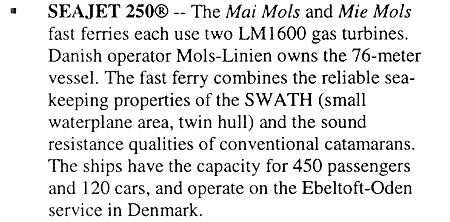・Stena AB HSS -- Twelve LM2500 gas turbines operate on three Stena Line AB semi-swath fast ferries: the Stena Explorer, Stena Voyager and Stena Discovery. The vessels began commercial operation in April 1996, July 1996 and June 1997, respectively. Each has two LM 1600 and two LM2500 gas turbines in a father/son COGAG configuration (see Figure 2). The LM 1600s are rated at 13.1 megawatts and the LM2500s are rated at 20.2 megawatts. Finnyards in Rauma, Finland built the vessels. The HSS fast ferries measure 126 meters long by 40 meters wide. Each vessel can achieve speeds of more than 40 knots and has the capacity for 1,500 passengers, 375 cars, or 50 trucks and 100 cars. Stena Line operates the vessels on the Irish Sea between the United Kingdom and The Netherlands.

・Foilcat -- Two Foilcat high-speed catamaran ferries that operate in Hong Kong each powered by two LM500 gas turbines. These foilborne vessels benefit from the very low weight of the gas turbines, and have reduced the required maintenance support compared to the earlier technology employed in similar vessels.
4 NAVAL APPLICATIONS
In the military marine sector, powering requirements are changing for a different reason. Instead of continued growth to larger ships with larger power requirements, a down sizing trend seems to be indicated. Instead of the larger frigates, destroyers, and cruisers that have dominated naval shipbuilding in recent years, interest in vessels of the offshore patrol vessel and corvette size is increasing. Ships of these classes normally have displacements around 2500 tons or less, as compared to the larger combatant vessels of 4000 tons and larger common in earlier programs.
Smaller ships do not necessarily mean less capable ships. The operational capability requirements for these smaller ships are in some ways more difficult to achieve than with larger ships, since the combat systems payload is extensive. In addition, the speed requirement for these ships must usually match the capability of an existing fleet. Larger ships have used multiple gas turbines to achieve the speed required, which is normally 30 knots or greater. Small ships of 1200-ton displacement can achieve this speed with a single gas turbine in a CODOG configuration. Ships with 2000 ton or more displacement have required two gas turbines or have settled for diesel propulsion and lower speed. To maximize the payload of these ships while providing the operational speed needed, a single gas turbine CODOG systems is desirable, because of the weight, space and cost savings.
Revival of the previously employed CODAG is occurring in military shipbuilding. This configuration allows the operation of diesel and gas turbine power sources simultaneously. The total power is therefore the sum of that available from all prime movers.
4.1 German F-124 Frigate
Germany's Navy will employ a CODAG configuration with a single gas turbine and two diesels, marking the first time the LM2500 will be applied in this arrangement for naval service. Three LM2500 aeroderivative gas turbines will power three Sachsen-class F124 frigates.
The LM2500 gas turbines will be used with diesel engines for total propulsion system output per ship of 51,600 horsepower.
4.2 South African Navy

Each MEKO A-200 corvette will use one LM2500 gas turbine directly connected with a gearbox to a 20-megawatt watarjet. Two interconnected shafts powered by diesel engines will propel two independent propellers.
Blohm & Voss, Hamburg, Germany and HDW, Kiel, Germany will build the MEKO A-200 corvettes. The first MEKO A-200 corvette will be commissioned in 2002.
4.3 Other Naval Experience
What follows are other recent naval applications that use gas turbines:
・11PG Patrol Boats -- Six LM500 aeroderivative gas turbines will power two 11PG high-speed patrol boats being built for the Japanese Maritime Self-Defense Force. Each 11PG mono-hull patrol boat will be equipped with three 6,000-shaft horsepower LM500 gas turbines driving waterjets. The 200-ton boats will be capable of reaching speeds in excess of 44 knots. Mitsubishi Heavy Industries will be building the patrol boats at its Shimonoseki, Japan shipyard. The first 11 PG will be commissioned in 2002.
・Bazan F-100 -- The units will be used on four F-100 class frigates being built by Bazan for the Spanish Navy. The F-100 class frigates will use the most sophisticated anti-air defense technology. Each F-100 frigate will use two LM2500 gas turbines: One LM2500 and one diesel engine per shaft will be used for CODOG configuration. GE delivered the first two LM2500 gas turbines in 1998, and the remainder in 2000, 2001 and 2002. The four frigates are expected to be commissioned in 2002 through 2005.